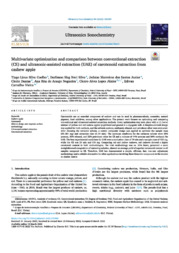Multivariate optimization and comparison between conventional extraction (CE) and ultrasonic-assisted extraction (UAE) of carotenoid extraction from cashew apple.
Multivariate optimization and comparison between conventional extraction (CE) and ultrasonic-assisted extraction (UAE) of carotenoid extraction from cashew apple.
Author(s): COELHO, T. L. S.; SILVA, D. S. N.; SANTOS JUNIOR, J. M. DOS; DANTAS, C.; NOGUEIRA, A. R. de A.; LOPES JÚNIOR, C. A.; VIEIRA, E. C.
Summary: Carotenoids are an essential component of cashew and can be used in pharmaceuticals, cosmetics, natural pigment, food additives, among other applications. The present work focuses on optimizing and comparing conventional and ultrasound-assisted extraction methods. Every optimization step took place with a 1:1 (w:w) mixture of yellow and red cashew apples lyophilized and ground in a cryogenic mill. A Simplex-centroid design was applied for both methods, and the solvents acetone, methanol, ethanol, and petroleum ether were evaluated. After choosing the extractor solvent, a central composite design was applied to optimize the sample mass (59?201 mg) and extraction time (6?34 min). The optimum conditions for the extractor solvent were 38% acetone, 30% ethanol, and 32% petroleum ether for CE and a mixture of 44% acetone and 56% methanol for UAE. The best experimental conditions for UAE were a sonication time of 19 min and a sample mass of 153 mg, while the CE was 23 min and 136 mg. Comparing red and yellow cashews, red cashews showed a higher carotenoid content in both methodologies. The UAE methodology was ca. 21% faster, presented a more straightforward composition of extracting solution, showed an average yield of superior carotenoid content in all samples compared to CE. Therefore, UAE has demonstrated a simple, efficient, fast, low-cost adjustment methodology and a reliable alternative for other applications involving these bioactive compounds in the studied or similar matrix.
Publication year: 2022
Types of publication: Journal article
Observation
Some of Embrapa's publications are published as ePub files. To read them, use or download one of the following free software options to your computer or mobile device. Android: Google Play Books; IOS: iBooks; Windows and Linux: Calibre.
Access other publications
Access the Agricultural Research Database (BDPA) to consult Embrapa's full library collection and records.
Visit Embrapa Bookstore to purchase books and other publications sold by Embrapa.

